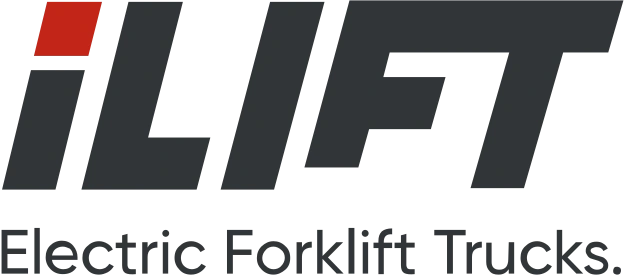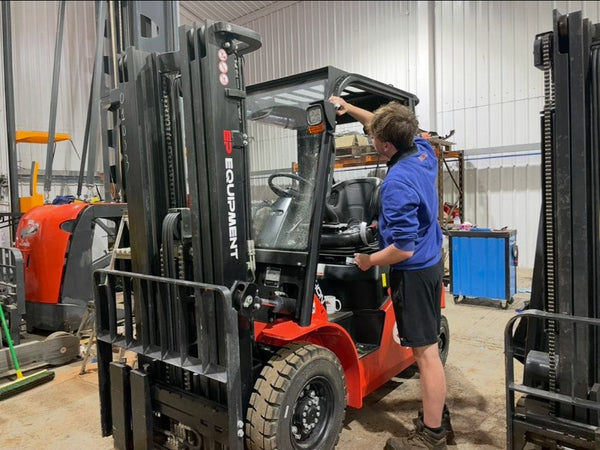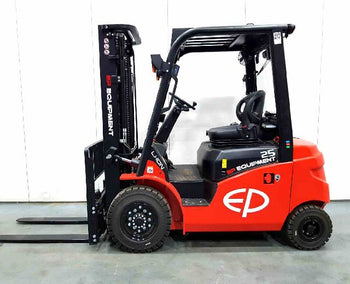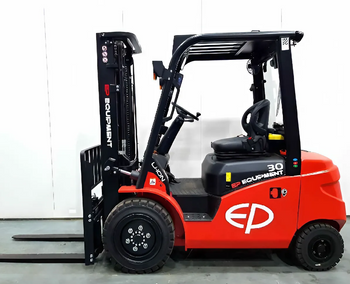There's a whisper going around the warehouse, a tantalising rumour that's caught the ear of many a fleet manager: "Lithium-ion forklifts are completely maintenance-free." It’s a compelling idea, isn't it? The thought of waving goodbye to the daily faff of battery watering, the messy acid spills, and the lengthy cool-down periods of traditional lead-acid batteries. And, to be fair, compared to their older siblings, lithium-ion power does feel like a breath of fresh air – a leap into a hands-off, hassle-free future.
But let's hit the brakes for a moment. While lithium-ion technology undeniably simplifies forklift management, labelling it "maintenance-free" is a bit like saying a brand-new car never needs a service. It's a tempting myth, but a myth nonetheless. The truth is, while the nature of the maintenance changes dramatically, some essential care is still crucial for these sophisticated machines. Overlooking these requirements won't just chip away at their much-vaunted benefits; it could cost you dearly in reduced lifespan, unexpected downtime, and even safety hazards.
So, let's pull back the curtain and reveal the straightforward, often overlooked, truths about keeping your lithium-ion forklift fleet in peak condition. It’s about smart, preventative care that maximises your investment, not a return to the dark ages of daily battery chores.
Debunking the Myth: What "Maintenance-Free" Really Means (and Doesn't!)
The "maintenance-free" buzz primarily stems from the comparison with lead-acid batteries. With lithium-ion, you genuinely eliminate daily battery watering, the need for dedicated battery charging rooms (thanks to no gassing), and the stringent cool-down periods. You can also embrace opportunity charging, topping up batteries during breaks without fear of damaging them, which is a big no-no for lead-acid. This dramatically reduces labour, infrastructure costs, and downtime.
However, "less maintenance" is not "no maintenance." These are advanced pieces of machinery, packed with sophisticated electronics and powerful battery packs. They still require attention, albeit of a different kind. Think of it less as traditional elbow grease and more as intelligent management and regular health checks.

Essential Care: Beyond the Battery
While the battery often steals the spotlight, the forklift itself still needs love and attention. These are industrial workhorses, enduring daily wear and tear.
Daily Pre-Operation Checks (The Operator's Role)
Empowering your operators with a quick daily checklist can prevent small issues from becoming big problems. This should include:
-
Visual Inspection: A quick walk-around to check for any obvious damage, leaks, or loose components.
-
Tyres: Check for cuts, excessive wear, and proper inflation (if pneumatic). Worn or improperly inflated tyres can affect stability, fuel efficiency, and component wear.
-
Forks and Mast: Inspect for cracks, bends, or wear. Ensure the mast operates smoothly, and the chains are properly tensioned and lubricated.
-
Controls and Gauges: Verify that all controls (lift, tilt, drive) respond correctly, and dashboard gauges (battery level, hour meter) are functioning.
-
Brakes: Test both the service brake and parking brake for effectiveness.
-
Lights, Horn, and Safety Devices: Confirm all lights (headlights, tail lights, warning lights), the horn, and any safety interlocks or alarms are working.
-
Steering: Check for smooth operation and excessive play.
-
Fluid Levels: While not as critical as internal combustion engines, check hydraulic fluid levels.
Regular Servicing (The Professional's Role)
Just like your car, your lithium-ion forklift needs periodic professional servicing. This goes beyond daily checks and delves deeper into the machine's mechanics and electronics. A qualified technician will:
-
Inspect and Lubricate: Check and lubricate all moving parts, including mast channels, linkages, and steering components.
-
Brake System: Conduct thorough checks and adjustments to the braking system.
-
Hydraulic System: Inspect hoses, cylinders, and pumps for leaks or wear.
-
Electrical System: Check wiring, connections, and components for signs of wear or damage. This includes the motor, controller, and contactors.
-
Software and Firmware Updates: Lithium-ion forklifts are highly reliant on their onboard Battery Management System (BMS) and vehicle control systems. Technicians will ensure all software is up-to-date, optimising performance, efficiency, and safety.
-
Component Wear: Assess the wear on critical components like brushes (if applicable to the motor type), bearings, and seals.
-
Safety Features: Thoroughly test all safety features, including overload protection, emergency stop buttons, and operator presence sensors.
These periodic services are crucial for identifying potential issues before they cause costly breakdowns and for ensuring the machine operates at peak efficiency.
The Heart of the Machine: Lithium-Ion Battery Care
The battery is undoubtedly the most expensive component of your lithium-ion forklift, and proper care will significantly extend its lifespan and performance.
Charging Smart: Not Just Any Plug Will Do
One of the biggest advantages of lithium-ion is the flexibility of opportunity charging. You can plug in during lunch breaks or between shifts without harming the battery. However, "smart" charging is key:
-
Use the Right Charger: Always use the charger specifically designed and approved by the forklift or battery manufacturer. Mismatched chargers can damage the battery, reduce its lifespan, and pose a safety risk.
-
Avoid Extreme Discharges: While lithium-ion batteries are robust, consistently running them down to 0% can stress the cells over time. Aim to recharge when the battery level drops to around 20-30%.
-
No Need for Full Cycles: Unlike some battery types, lithium-ion batteries don't suffer from a "memory effect." You don't need to perform full discharge/recharge cycles to maintain capacity. In fact, partial charges are better for battery longevity.
-
Keep it Connected: When a lithium-ion forklift isn't in use, especially overnight or during longer breaks, it's often best to leave it connected to its charger. The BMS will manage the charge, keeping it topped up and balanced.

Temperature Management: The Silent Killer
Lithium-ion batteries are sensitive to extreme temperatures. Operating or charging them outside their optimal range can significantly degrade performance and shorten lifespan.
-
Optimal Operating Temperature: Most lithium-ion batteries perform best between 0°C and 45°C.
-
Avoid Extreme Heat: High temperatures accelerate battery degradation. If possible, avoid operating or charging in areas where temperatures regularly exceed 45°C.
-
Avoid Extreme Cold: While less damaging than heat, very cold temperatures (below 0°C) can temporarily reduce performance and charging efficiency. Some batteries have built-in heaters to mitigate this.
-
Ventilation: Ensure adequate airflow around the battery compartment, especially during charging, to dissipate any heat generated.
Proper Storage: Hibernation for Health
If a forklift (or its battery) is going to be out of commission for an extended period (weeks or months), proper storage is vital:
-
Partial Charge: Do not store a lithium-ion battery fully charged or fully discharged. The ideal storage State of Charge (SOC) is typically between 30-60%. Around 50% is often recommended.
-
Cool, Dry Environment: Store the battery in a cool, dry place, ideally between 10°C and 20°C, away from direct sunlight or heat sources.
-
Periodic Top-Up: For very long-term storage, check the battery every few months and top it up to the recommended storage SOC if it has self-discharged significantly.
The Role of the Battery Management System (BMS)
The BMS is the unsung hero of your lithium-ion battery. It's the brain that constantly monitors voltage, current, and temperature, protecting the battery from overcharging, over-discharging, and overheating. Ensure your BMS is always functional and that any alerts it provides are heeded. Regularly ensuring BMS firmware is updated by a professional will keep your battery operating at its safest and most efficient.
Maximising Uptime & Saving Money
The beauty of lithium-ion forklifts lies not just in reduced maintenance but in their ability to boost productivity and cut costs in other ways.
-
Faster Charging Speeds: Lithium-ion batteries charge significantly faster than lead-acid, often reaching 80% charge in less than an hour. This means less time waiting and more time working.
-
No Battery Swapping: For multi-shift operations, opportunity charging often eliminates the need for expensive and labour-intensive battery swapping, further reducing downtime and the risk of injury.
-
Longer Lifespan: With proper care, lithium-ion batteries can last 3-4 times longer than their lead-acid counterparts, significantly reducing your total cost of ownership.
-
Consistent Power Delivery: Unlike lead-acid, lithium-ion batteries maintain consistent voltage throughout their discharge cycle. This means no power fade towards the end of a shift, leading to more productive and safer operations.
-
Energy Efficiency: Lithium-ion batteries are inherently more energy-efficient, meaning more of the power drawn from the grid goes directly into productive work, saving on electricity bills.

Safety First: A Different Set of Precautions
While lithium-ion batteries eliminate the risks associated with hydrogen gas emissions and acid spills, they introduce a different set of safety considerations, primarily related to thermal events.
-
Physical Damage: The biggest risk comes from physical damage to the battery pack, which can compromise the internal cells and lead to short circuits or thermal runaway. Always handle batteries with care and immediately report any impacts or visible damage. Never attempt to use a visibly damaged battery.
-
Charging Environment: While no gassing occurs, ensure charging areas are well-ventilated to dissipate any minor heat and keep the environment cool.
-
Fire Safety: In the unlikely event of a lithium-ion battery fire (often characterised by intense heat and smoke), do NOT use water. Water can exacerbate some lithium fires. Specialised Class D or LFX (Lithium Fire Extinguisher) chemical extinguishers are recommended. Immediately evacuate the area, call emergency services (999 in the UK), and keep a safe distance.
-
Manufacturer Guidelines: Always adhere strictly to the manufacturer's safety guidelines for handling, charging, and storing lithium-ion batteries.
The Pay-Off: Time, Money, and Peace of Mind
So, while the dream of a truly "maintenance-free" forklift remains just that – a dream – the reality of lithium-ion is still incredibly compelling. By understanding and implementing these straightforward maintenance requirements and best practices, you're not adding significant workload; you're adopting a smarter approach to asset management.
This proactive care translates directly into:
-
Extended Battery Life: Maximising your expensive investment.
-
Reduced Downtime: Keeping your forklifts working and earning.
-
Enhanced Safety: Protecting your staff and your assets.
-
Lower Operating Costs: Saving on energy, replacement parts, and labour.
Ultimately, embracing the truth about lithium-ion forklift care empowers you to unlock their full potential, ensuring your fleet remains a powerful, productive, and profitable asset for years to come. It’s not about doing nothing; it’s about doing the right things, smarter.





